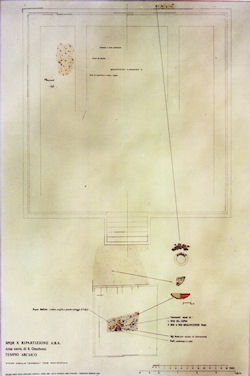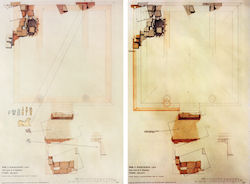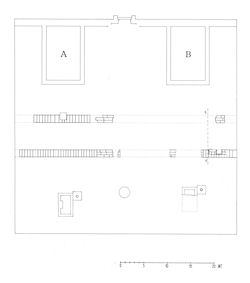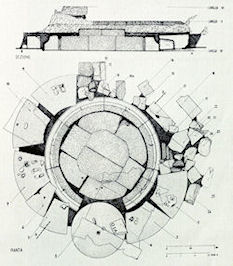
Figure 70: Remains of the pre-temple phase in the area of the Archaic temple (Pisani Sartorio et al. 1989, 24, tab. 3)
The substantial amount of evidence for the development of the 'sacred area' of S. Omobono presented elsewhere has been variously interpreted. Unsurprisingly, the Archaic phases of the temple complex, which have provided the thrust for much of the work conducted at the site, have been at the centre of scholarly debate. Nevertheless, a substantial literature has also grown concerning the chronology and historical significance of later phases of development. This section outlines the major interpretative problems associated with S. Omobono.
The earliest archaeological levels at the site, dated by Gjerstad to the end of the 7th and early 6th centuries BCE, were interpreted as pertaining to a phase of hut occupation on the basis of a single fragment of wattle and daub uncovered at the bottom of the stratigraphic sequence (Gjerstad 1962, 101). After this initial period of occupation, Gjerstad envisioned two additional phases of activity consisting of layers deposited to raise the level of the area before the construction of the Archaic temple. These phases were dated within the 6th century BCE (1962, 101-2).

Figure 70: Remains of the pre-temple phase in the area of the Archaic temple (Pisani Sartorio et al. 1989, 24, tab. 3)
Although already suggested by Gjerstad, the possibility that the area had been designated as 'sacred' even before the construction of the first temple building was strongly advocated by Ioppolo, who interpreted a patch of burnt remains near the altar of the Archaic temple and its associated faunal assemblage (limited to the sacrificial triad of the suovetaurilia) as a sacrificial pit (Figure 70). Additionally, citing the substantial quantity of roof tiles attested within the layers of this phase, Ioppolo hypothesised the presence of a pre-temple building linked to the sacrificial pit (1989a, 29-31), which he identified as the sacellum Carmentae mentioned in connection with this area in later literary sources (Ioppolo 2000, 168-71; for a list of references to the cult of Carmenta in the literary sources, see Pisani Sartorio 1993, 241). Ioppolo attributed this latest pre-temple phase to the end of the 7th or the beginning of the 6th century BCE, citing as evidence an Etruscan inscription associated with the pit (Ioppolo 1972, 12-14).
Overall, because of the limited extent of the soundings and the relative scarcity of archaeological material from the layers preceding the construction of the Archaic temple, the character of these early phases did not engender much discussion. Far more controversial subjects were the chronology and architectural articulation of the two documented phases of the Archaic temple. As outlined in section 3.2, several campaigns of fieldwork were directed at clarifying this period of the site's development. Based on the 1959 fieldwork, Gjerstad proposed a date in the early 5th century BCE for the first foundation of the Archaic temple and placed its reconstruction roughly a century later (Gjerstad 1962, 102). This chronology, which was intended to supplant the 6th-century BCE date initially put forth by Colini (1938b, 281), was immediately disputed (see, for instance, Peroni 1962, which appeared in the same issue of the Bullettino della Commissione Archeologica Comunale di Roma as Gjerstad's report).

Figure 71: Structural remains of the first and second podia of the Archaic temple (Pisani Sartorio et al. 1989, 25-26, tables 4-5
The three subsequent campaigns of excavation carried out in this area all placed the Archaic temple within the 6th century BCE. Only the 1962-1964 and 1977-1978 fieldwork, however, provided diagnostic evidence to separate its two phases chronologically. These phases were distinguished on the structural evidence of blocks relating to the reconstruction of the western edge of the podium (Figure 71; Gjerstad 1962, 33-34; it should be noted that the second podium was not attested in the rear of the structure; Pisani Sartorio and Virgili 1979, 43). Based on the results of these two campaigns of fieldwork, Ioppolo identified the chronological break between the two phases as the mid-6th century BCE (1972, 14), while Pisani Sartorio and Virgili proposed to raise it to the 570s BCE (1979, 44). The latter hypothesis was based on the attribution of a substantial assemblage of votive material datable between the second quarter of the 6th century and c. 540 BCE to the second phase of the Archaic temple (see, for instance, section 3.4.9). This has proved particularly controversial, however, as it contradicted conventional chronologies for the 6th-century BCE structures based on the stylistic evidence of the recovered architectural terracottas, as well as supposed references to the foundation of the temple in later literary sources.
Because much of the literature concerning S. Omobono focuses on the architectural decoration of the two phases of the Archaic temple, chronological arguments based on stylistic analyses of the terracottas from the site are complex and varied. Although a significant quantity of decorative elements had already been unearthed in 1937-1938 (Colini 1938b, 281), only the later soundings enabled a comprehensive evaluation of the chronology and structural organisation of this growing corpus of material. The post-war excavations consistently yielded terracotta architectural elements in layers associated with the destruction of the second phase of the Archaic temple (Mura Sommella 1977a, 63-64); as a result, the stylistic attribution of the fragments to one or the other phase of the structure assumed a central place in discussions of the site's chronology.
In the report of the 1959 fieldwork, Gjerstad placed the terracottas stylistically to the beginning of the 5th century BCE (according to his chronology, the first phase of the temple), explaining their stratigraphic association with the second phase of the structure by positing that they had been reused in the reconstructed temple building (Gjerstad 1962, 98-99). The debate concerning the decoration of the temple, however, was only fully opened by a thorough study of all known fragments by Mura Sommella (1977a). Citing both particular stylistic and iconographic attributes of the terracottas and considerations of their structural position, Mura Sommella attributed much of the assemblage to the second phase of the structure, beginning around 540-530 BCE—a date obtained by assuming that the building must have been in use for some time before its destruction in the late 6th century BCE (see Adornato 2003 for a revision of this chronology).
While the subject of the exact placement and iconographic associations of individual decorative elements within the two phases of the temple stimulated a lively discussion (e.g. Mura Sommella 1977b; Staccioli 1979; Mertens-Horn 1997; Parisi Presicce 1997), few reconstructions radically challenged Mura Sommella's identification of two distinct decorative assemblages. Cristofani (1990b), for instance, pointed out that all the architectural terracottas from the site could be attributed on stylistic grounds to the second phase of the temple building, for which he accepted Mura Sommella's date of 540-530 BCE. Mura Sommella herself, in a subsequent contribution, conceded that the terracotta decoration could in theory belong to a single architectural phase or even two contemporaneous buildings (1990, 116), citing later literary accounts concerning the foundation of two temples by Servius Tullius (Dion. Hal. 4.27.7; Liv. 5.19.6). Nevertheless, the attribution of the terracottas from the site to a single structural phase was questioned by Colonna, who argued on the basis of vague references from unpublished excavation notes that the material in question could be divided into two chronologically distinct assemblages on the evidence of stratigraphic as well as stylistic and iconographic details (1991).
Archaeologically, the destruction of the Archaic temple by fire at the end of the 6th century BCE (Gjerstad 1962, 38; Pisani Sartorio 1977, 59; Virgili 1977, 28-30) seems to have been followed by a substantial effort to raise the level of the area in preparation for the construction of a large platform supporting two twin temples, orientated on a slightly different axis from the underlying Archaic structure (Ioppolo 2000, 171-73). A stratigraphically complex fill was documented in all the deep soundings conducted within the temple platform (Colini 1938b, 280; Gjerstad 1962, 102; Ioppolo 1972, 17; Virgili 1977, 26-28; for the different stratigraphic sequence outside the platform, see Pisani Sartorio and Virgili 1979, 43). Ioppolo, extrapolating the average thickness of this deposit as documented by the 1962-1964 soundings to the entire platform, suggested that its construction would have necessitated some 30,000 cubic metres of soil, probably obtained from the adjacent Capitoline (Ioppolo 1972, 17; for the source of the sediment, cf. Colini 1962, 6, and 1977, 9-10). Although the large fill was interpreted by most as a preventative measure against the frequent floods in the area (e.g. Colini et al. 1978, 424; Pisani Sartorio 1995, 283), Gjerstad argued that it served to raise the level of the roof of the twin temples above the crest of a late 3rd-century BCE agger attested by Colini immediately behind the temple platform (Gjerstad 1962, 100, 102). This interpretation, however, was little more than an attempt by Gjerstad to bolster the case for his later chronology of the sequence for early Rome.
The platform containing the fill preserves evidence of at least four construction phases, attested by superimposed pavements (three in tufo and one in travertine; the identifications of the different types of tufo in the available published reports and archival documents are often imprecise and contradictory, and therefore are not presented here). The majority of the excavators dated the earliest platform to between the end of the 6th and the early 5th centuries BCE on the basis of the latest materials from the underlying fill (Pisani Sartorio 1977, 59-60; Colini et al. 1978, 424; Pisani Sartorio and Virgili 1979, 44). Besides Gjerstad's chronology (see below), the only major disagreement with such a date was raised by Coarelli. Faced with the absence in the literary sources of any references to work in the area during this period, he tentatively dated the construction of the platform to the early 4th century BCE (Coarelli 1988, 216-19), the period to which later authors attributed a restoration of the Temple of Mater Matuta by Camillus (Liv. 5.19.6; Plut., Cam. 5). Specifically, Coarelli argued that the area was abandoned for nearly a century after the destruction of the Archaic temple, citing brief remarks by Ioppolo and Virgili to the effect that the levelling of the area after the fire and the deposition of the fill layers were probably not contemporaneous (Ioppolo 1972, 15-17, n. 17; Virgili 1977, 28). Coarelli's date further hinges on a supposed terminus ante quem provided by a single fragment of black-gloss ceramic datable to around 300 BCE, which he personally removed from an exposed lens of sediment between the first and second pavements of the platform in a spot 'prossimo al centro dell'area' (close to the centre of the area) (Coarelli 1979, 123-24; 1988, 214; for a critique of this datum, see Virgili 1979, 124).
Although a date of the early 4th century BCE had been assumed before Coarelli's contributions (Torelli 1973, 100), it otherwise received little support. In the absence of sound evidence but pressed to identify an archaeological correlate for the literary references to the area, others identified the reconstruction by Camillus with the second pavement of the platform (Pisani Sartorio and Virgili 1979, 44). Alternatively, Sommella (1968, 65) argued in passing that the first and second pavements of tufo blocks, which in parts of the platform are in direct contact, might belong to a single phase of construction. The latter proposition, however, is perhaps called into doubt by the documentation of a large water cistern between the cellae of the twin temples. A brief report describing this structure attributed it to the construction of the overlying second pavement, as part of the first pavement of the platform was dismantled to accommodate it (Virgili 1988). Finally, it should be noted that, as with the other phases of the temple, Gjerstad argued for a late date for the platform, identifying it as part of the reconstruction recorded by the literary sources after the fire of 213 BCE (Liv. 24.47.15 and 25.7.6; Gjerstad 1962, 100-1).
The chronology of later Republican interventions in the area, though by no means fully resolved, rests on a relatively sounder footing. To begin with, the second pavement supported two C-shaped altars with associated wells, which were generally dated, together with the pavement, to the early 4th century BCE (e.g. Pisani Sartorio and Virgili 1979, 44; for a discussion of the altars from S. Omobono in relation to similar monuments from Lavinium and elsewhere, see Castagnoli 1962). Of course, this attribution was disputed by those who preferred a later date for the construction of the second pavement (Torelli 1973, 100, for instance, interpreted the construction of the altars as a subsequent intervention).
The altars were covered by a third pavement, built of thin tufo slabs, which was dated on the basis of evidence from the 1961-1962 fieldwork to the beginning of the 2nd century BCE (and thus interpreted as part of the reconstruction after the fire of 213 BCE; Mercando 1966). A similar date was advanced by Sommella through a study of two parallel foundations of tufo blocks laid across the platform as supports for the columns of the temples of this phase (Figure 72). Based on his palaeographic study of quarry marks on some of the blocks of these structures, he suggested that they were constructed in the 3rd century BCE. He then further narrowed this date to the last decade of the century on the basis of the literary evidence for the fire of 213 BCE; Sommella 1968).

Figure 72: Schematic plan of the foundation courses of tufo blocks in front of the cellae of the twin temples (Sommella 1968, 64, fig. 2)
The 1961-1962 soundings further revealed fragmented blocks that were initially interpreted as pertaining to two monuments, one square and one circular, installed within the second pavement of the platform (Figure 73; Mercando 1966, 44-52; Ioppolo 1966, 68-90). Part of the base of the circular structure was found in situ, with additional blocks and all the elements of the square monument (or monuments, as discussed below) deposited nearby (Figure 74). Thus, while the position of the circular feature, approximately halfway between the two altars, is certain, the square monument(s) need not necessarily have been set in the same area (e.g. Ioppolo 1966, 88).


Figure 73: Blocks belonging to the circular and square monuments (Mercando 1966, 45, fig. 7)
Figure 74: Plan of the blocks of the circular and square monuments (Ioppolo 1966, tab. 1)
Five of the fragments from the square monument(s) were found to be inscribed. After some confusion regarding the reconstruction of these elements (Ioppolo 1966, 86-87; Degrassi 1966), Torelli argued that they could be attributed to two identical square monuments and interpreted the inscription as commemorating the capture of Volsinii by Fulvius Flaccus in 264 BCE (Figure 75; Torelli 1968, 71-75; 1973, 103-4). Building on Torelli's widely accepted reconstruction, Coarelli argued that the second pavement of the platform, on which the square monuments were likely installed, should be seen as part of a radical reconstruction of the area by Flaccus; anticipating the possible objection that no such event is recorded in the literary sources, he pointed out that the period between 293 and 216 BCE as a whole is not well documented historically (1988, 214-15).

Figure 75: Reconstruction of four of the five inscribed elements by Torelli (1968, 72, fig. 1)
The final pavement of the platform corresponds to a substantial reorganisation of the area in the Imperial period. The only excavation data concerning this phase, obtained in the 1974-1976 fieldwork, relate to the construction and use of one of the tabernae installed within the south-eastern quarter of the platform in the course of the 2nd century CE (the remains of additional tabernae were also documented on the north-eastern edge of the platform, abutting the cella of temple B; Ramieri 2002b, 568-69 and 2005a, 25). The taberna, which probably sold pigments (Colini et al. 1978), appears to have been in use until the beginning of the 4th century CE (Virgili 1977, 22-26; Colini et al. 1978, 422-24).
Despite the lack of excavation data, reconstructions of several aspects of the development of the area during the Imperial period were attempted through the analysis of surface features. The remains of large travertine slabs throughout the platform attest to a final paving of the complex in connection with a reconstruction of the cellae of the twin temples, which received walls in travertine blocks and mosaic pavements (Mucci 1987, 97; Ramieri 2005a, 25). The chronology of these restorations was derived from the presence of brick stamps datable to 123-124 CE, which were documented in situ within drainage channels and other structural remains thought to pertain to this phase (Colini et al. 1978, 421-22; Ioppolo 1988b, 451). While the exact structural and chronological relationship between the tabernae and the restoration of the area in travertine remains unclear, it was proposed that the southern half of the platform, stripped of its ritual role, came to serve as a plaza for commercial and other activities sometime in the course of the 2nd century CE (Colini et al. 1978, 422; Ioppolo 1988b, 452-54).
While the reconstruction of the platform and temples in travertine is thus generally placed within the Hadrianic period, other elements within the platform have been taken as evidence of earlier Imperial additions to the area. In particular, six foundations in opus caementicium between the cellae of the twin temples, which Coarelli has sought to identify as part of the porta Triumphalis, have been assumed on the basis of complex topographic arguments to represent reconstructions of an originally Domitianic monument (Coarelli 1968; 1988, 363-414; for a detailed description of the foundations, see Ioppolo 1988a).
This review of the most prominent issues concerning the development of S. Omobono, it is hoped, has provided a glimpse of the lack of information and confusion that plague our understanding of this important archaeological context. Owing to its limited extent and narrow methodological scope, the fieldwork conducted since the 1930s has failed to produce the necessary data to formulate even a basic understanding of the chronology and character of the major phases of activity in the area. Section 7 touches on the methods and goals of the S. Omobono Project, which is designed to situate the site within the shifting sociocultural fabric of Rome and central Italy more generally.
© Internet Archaeology/Author(s)
University of York legal statements | Terms and Conditions
| File last updated: Mon Mar 12 2012